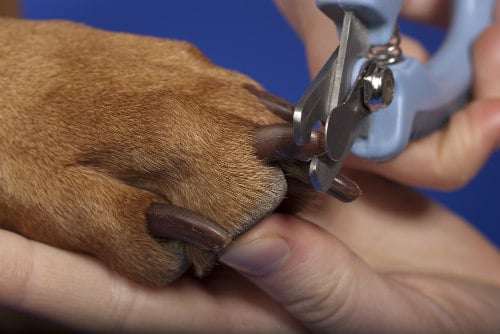There’s nothing like a trip to the nail salon to make you feel pampered and polished. It’s an opportunity to sit back and relax as the technician takes your nails from rough and jagged to smooth, shiny and uniformly shaped. Who doesn’t enjoy a little confidence boost every now and then?
If your dog could speak, it would probably be the voice of dissent here. Nails are a touchy topic for most dogs, with the prospect of getting them trimmed invoking indifference at best and panic at worst. While there are a lucky few dog owners whose pups don’t put up a fight when the clippers come out, chances are that your dog doesn’t quite get the appeal of a pedicure.
Unfortunately, most dogs need regular nail trimmings whether they want them or not. So what’s the best way to do it while minimizing discomfort for both you and your dog? Read on to learn more about your dog’s nails, how to maintain them and what to do when the situation becomes too much to handle.
Canine Claws: All About Dog Nails

Anatomy of a Nail
A dog’s nail may look quite different from ours, but it’s actually surprisingly similar in terms of composition. Both humans and dogs have nails that are made out of keratin, a tough, durable protein that’s comprised of dead cells and appears fibrous under a microscope. Difficult to dissolve and digest, keratin is also the main component in hair, hooves and the outermost layer of human skin.
Dogs and humans both have cuticles as well, though they take on very distinct forms in both of our species. Ours are thin, pliable layers of see-through skin located at the bases of our nails. Their function is to protect the newest nail growth and the surrounding skin from infection; some people like to push their cuticles back to expose the new growth and lengthen the appearance of the nail.
A dog’s cuticles, on the other hand, are internal and far more sensitive than a human’s. More commonly known as the “quick,” a canine cuticle extends further along the length of the nail and is packed with nerves and blood vessels. Though humans can manipulate or even remove our cuticles with little or no pain, a dog’s quick is a necessary part of its nail and, if injured, will hurt and bleed.
If your dog has light-colored nails, you’ll be able to see the quick: it’s the darker, rounded, opaque part of the nail close to the paw, often pink or reddish in color due to the blood vessels inside it. The rest of the nail is more transparent and less pigmented, usually white but sometimes yellowish in color. You won’t be able to see the quick if your dog has darker nails, but the structure is the same regardless of nail color.
One important difference between dog and human nails is the number of layers they contain. We both have a hard outer layer in which the keratin is perpendicular to the direction of growth; this is why our nails tend to break off in little horizontal slivers. But dogs have another layer of keratin underneath that’s softer and runs in the same direction as the growth, causing the nail to grow in a curved shape.
Beyond Beauty

For the most part, long nails are more of an inconvenience than a health issue for humans. When they get too long, the edges begin to chip and catch on things, and they may start to get in the way when doing things like typing or putting shoes on, but that’s the extent of the damage. Though long nails don’t usually have any detrimental effects on our health, the same can’t be said for dogs.
When a dog’s nails get too long, things can get painful fast. Because of the way they curve, dog nails will touch the ground when they get long, meaning that every step exerts force on the nails. The extra pressure gets picked up by the nerves in the quick, causing discomfort and pain every time the foot meets the floor.
Over time, more serious health problems can arise from overgrown nails. The dog may become lethargic, avoiding walking and running because of the pain associated with its nails making contact with the ground. This can lead to weak joints, weight gain and behavioral problems arising from unspent energy.
Even if the dog continues to be active despite its overgrown nails, they may still be causing damage. The increased pressure being absorbed through the nails can push the foot and foreleg joints out of alignment, resulting in a flat-looking foot. Misshapen feet make walking and running more difficult, increasing the dog’s risk of injury and discouraging physical activity.
A dog’s nail grows out in a curved shape, and if it becomes too long it can start to curve under the foot. In severe cases, the nail will begin to dig into the paw pad, eventually becoming embedded in it. This extreme ingrown nail needs to be removed by a vet.
Anyone who’s ever broken a nail can attest to how unpleasant it is, but it’s an even worse experience for a dog. A dog’s quick will get longer over time if its nail isn’t trimmed, eventually growing out so far that when the nail breaks, the quick breaks off with it. When exposed, the nerves and blood vessels cause excruciating pain and the nail is likely to become infected.
Time for a Trim?
So how do you know when your dog’s nails are due for a clipping? The easiest way to tell is to listen. When your dog walks on a wood or tile floor, you shouldn’t hear any clicking noises – these are made by the nails making contact with the floor, a sure sign that they’re too long.
If your dog is highly active, especially on hard or rough surfaces, you may not need to trim its nails often, if at all. A dog’s nails are designed to give it good grip when running and digging, activities that will naturally wear down the nails if done on a daily basis. Wild canines get by just fine without nail clippings because with enough use, the nails maintain themselves.
Most pet dogs, however, don’t use their nails enough to not need regular trimmings. Every one to two months, they’ll get long enough that the clicking footsteps resume, indicating that it’s time to get the clippers out.
Making the Cut: Nail Clipping Step by Step
Learn from the Best
If you’ve never clipped your dog’s nails before, it’s a good idea to watch a professional do it once or twice before you attempt it yourself. Groomers and vets have lots of experience clipping nails and they can show you how short your particular dog’s nails should be. This is especially important if your dog has dark nails that obscure the quicks – you don’t want to accidentally cut too far and damage the quick.
Prepare Your Pup
Many dogs simply don’t like having their feet touched, whether they’re getting their nails cut or not. You’ll want to acclimate your dog to the sensation of having its paws handled before you even break out the clippers. Spend a few days before the pedicure touching and holding your dog’s paws, and make sure to provide treats when your touch is met without panic or displeasure.
Once your dog is comfortable with you handling its paws, you can try doing so while holding the clippers. Don’t start trimming yet, just keep holding and touching the feet and nails with the clippers in your other hand, squeezing them so they make a sound. Keep rewarding your dog with treats and before long the clippers will seem like no big deal.
Assemble Your Tools

You’ll want to have three things on hand when you clip your dog’s nails: the clippers, styptic powder, and treats.
Dog nail clippers come in several types. Scissor-style and plier-style clippers are usually recommended; guillotine-style clippers are favored by some but can be painful for the dog as they apply a crushing force to the nail. Some people like to use a Dremel tool to grind the nail down as opposed to cutting it, but the noise made by the motor can be upsetting to the dog.
Hopefully the trimming will go smoothly with no bleeding, but you should always be prepared with styptic powder just in case. Styptic powder, when applied to a wound, will cause the blood to clot and stop bleeding; many also contain a numbing or painkilling agent to help alleviate any discomfort. If you don’t have styptic powder, you can use flour, cornstarch or baking soda instead, though these will only stop bleeding, not pain.
Treats are a must-have item when introducing your dog to anything new, and that includes nail clipping. A
Assume Position
It’s easiest to trim your dog’s nails if it’s lying down. A table is ideal, but if it’s not possible to get your dog on a table you can clip nails on the floor as well. You may need to roll the dog on its side or hold its head and neck down with your arm to prevent it from getting up and leaving.
Large or very wiggly dogs may be too much for one person to handle. You may need to enlist a helper to trim a rowdy dog’s nails. One person can hold the dog in position while the other person uses the clippers.
Paw in Hand
Hold your dog’s paw in the opposite hand as your clippers, with your thumb on the paw pad and your other fingers on the toe near the base of the nail. Your grip should be firm but not tight, as too much squeezing can be painful and cause the dog to squirm. Remember to remain calm and collected, as your dog will pick up on any anxiety you feel and mirror it.
Hold the clippers at a right angle to the nail and position them where you want to make the cut. If you can see the quick, cut the nail to around 2mm before the quick. Wait until the dog is still and squeeze the clippers swiftly and tightly to make a fast, clean cut.
If you can’t see the quick, you’ll need to make several small cuts, checking the nail after each cut to see if you’ve reached the quick. The center of the nail will begin to turn gray or flesh-toned as it nears the quick, so stop cutting when you see this color change. If there’s any doubt, stop cutting.
The nail should feel hard and firm in the clippers. If it begins to feel soft or squishy, stop cutting; this means you’re about to cut into the quick. Make sure to gauge your dog’s reaction consistently throughout, stopping if you hear any yelping or feel any twitching or jumping.
When Things Go Wrong
Sometimes nail trimming doesn’t go as smoothly as planned. Maybe your dog’s paw twitched as you were squeezing the clippers, causing you to cut into the quick. Or perhaps despite your best efforts, you just can’t get your pup to be still and calm enough to get the job done.
If you cut the quick and it begins to bleed, you’ll want to get the styptic powder out. Hold the nail in the powder or dab some onto the wound; the bleeding should subside within a few minutes. Bleeding that won’t stop on its own after five minutes or so needs to be addressed by a vet.
Some dogs, especially those who have had bad experiences with nail clipping before, are just too anxious for an at-home pedicure. In this case, you may need to take it to the vet for a nail trim. If the pre-cutting panic is severe, your vet may also prescribe anti-anxiety or sedating medication for you to give to your dog before clipping its nails.
